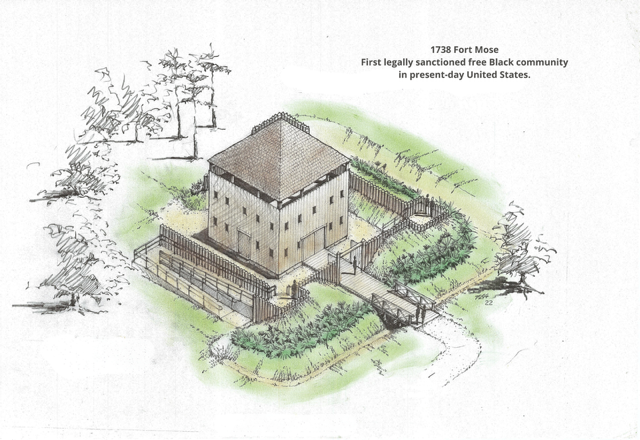Florida State Parks Foundation unveils renderings for Fort Mose reconstruction
Florida State Parks Foundation unveils architectural renderings for 1738 Fort Mose reconstruction
TALLAHASSEE, Fla. –
Fort Mose Historic State Park - America’s first site of freedom - has taken a major step toward realizing the dream of reconstructing the 1738 Fort Mose on park property in St. Augustine.
The Florida State Parks Foundation, in conjunction with partners from the Florida State Parks, the Fort Mose Historical Society and Drs. Kathleen Deagan and Jane Landers, today unveiled a draft architectural rendering of the 1738 Fort Mose. Groundbreaking for the life-sized, full-scale reconstruction is scheduled for fall 2023, with completion anticipated in early 2024.
“Seeing this draft rendering for the first time takes your breath away,” said Julia Gill Woodward, CEO of the Florida State Parks Foundation. “This project has been a dream for many years, and it’s incredibly exciting to get the first glimpse of what it will look like when completed.”
Fort Mose was the site of the first legally sanctioned free African settlement in what is now the United States. In 1738, the Spanish governor of Florida chartered the settlement of Gracia Real de Santa Teresa de Mose, or Fort Mose, as a place for formerly enslaved people fleeing from the English colonies in the Carolinas. Their only stipulations were to declare allegiance to the king of Spain and join the Catholic Church.
The Fort Mose Historical Society set a goal to reconstruct a representation of Fort Mose in the mid-1990s. The project accelerated in 2022 when the Foundation earned a competitive grant of $933,500 from the Florida African American Cultural and Historical Grants Program to aid in construction costs.
The Foundation also secured $250,000 in matching funds from Florida State Parks, the Jacksonville Jaguars Foundation, Florida Blue, The Community Foundation for Northeast Florida and St. Johns County.
“We love hosting visitors at Fort Mose Historic State Park, but people are always asking, ‘So, where is the fort?’” said Charles Ellis, president of the Fort Mose Historic Society. “Fort Mose has one of the most inspiring and fascinating stories in our nation’s history, and having this reconstruction on site will help us to share it in a fresh, comprehensive way. We can’t wait to see it finished.”
The Fort Mose site was acquired by the state of Florida in 1989 and was designated a National Historic Landmark and added to the National Register of Historic Places in 1994. In addition to a museum and visitor center, the 41-acre park also offers opportunities for kayaking and canoeing, wildlife viewing and picnicking.
“Fort Mose is one of our state’s most significant cultural resources, and the fort replica will help us tell the story of this historic place,” said Chuck Hatcher, director of Florida State Parks. “This is all coming together as the result of years of determination from many different people, and we are grateful to see everyone’s hard work and dedication paying off in such an amazing way.”
Fact Sheet: The History of Fort Mose Did you know?
- Fort Mose (officially Gracia Real de Santa Teresa de Mose) was the first legally sanctioned free Black community within the present boundaries of the United States. Fort Mose Historic State Park is now a National Historic Landmark (NHL) and a Site of Memory of the UNESCO Slave Route Project.
- Fort Mose (pronounced “Moh- say”) was established in 1738 as a military and residential community, guarding the northern boundary of Spanish St. Augustine. -This is a story of freedom. Fort Mose men and women escaped enslavement on British plantations. Along their perilous journey to St. Augustine they were often aided by Natives, thus forging an early Underground Railroad that ran south.
Background
- St. Augustine was the first permanent Spanish settlement within the present-day United States, established in 1565. Jamestown was the first permanent English settlement, established in 1607.
- The first freedom seekers reached St. Augustine in 1687. This group included eight men, two women and a nursing child, traveling by dugout canoe.
- In 1693, King Charles II of Spain issued a royal proclamation granting liberty to all freedom seekers who would accept the Catholic religion. Spanish Florida would benefit from the specialized skills that freedom seekers had acquired within Africa and while on British plantations. Additionally, a steady loss of enslaved workers weakened the British plantation economy.
Fort Mose History 1687 The first group of freedom seekers arrives in St. Augustine. 1738 Fort Mose is established on St. Augustine’s northern border. 1740 British troops launch a month-long siege of St. Augustine. Allied Spanish and Native forces and Fort Mose free Black militia win the Battle of Bloody Mose, although, during the battle, the fort is destroyed. St. Augustine remains under Spanish control. 1740 Fort Mose citizens move into town, living peaceably among local Spanish and Native residents. 1752 Fort Mose is rebuilt, close to the original site. 1763 England gains control of Spanish St. Augustine, upon conclusion of the Seven Years War. Most citizens of Fort Mose and St. Augustine evacuate to Cuba.
The Legacy of Fort Mose (from NHL Designation) Black inhabitants of Fort Mose played a nationally significant role in the colonial conflict between England and Spain.



